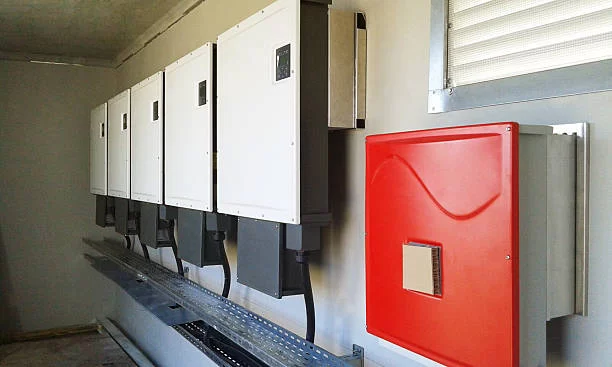Solar Inverter Cabinet: The Key Component for Solar Energy Conversion
In the domain of renewable energy, solar inverters stand as indispensable components in the process of converting sunlight into usable electricity. These devices play a critical role in transforming the direct current (DC) electricity generated by solar panels into alternating current (AC) that can be used by electrical grids or consumed directly by households and businesses. The solar cabinet, encompassing not just the inverter but also crucial ancillary components, is pivotal to ensuring the efficiency, reliability, and longevity of solar energy systems. This article explores the multifaceted role of the solar inverter cabinet, its components, operational principles, technological advancements, and the future trajectory of this essential element in solar energy conversion.
Understanding the Role and Components
The primary function of a solar cabinet is to convert the DC electricity produced by solar panels into AC electricity suitable for powering homes, businesses, and the electric grid. This conversion process involves several key components housed within the cabinet:
- Inverter: At the heart of the cabinet lies the inverter itself, which performs the core function of DC to AC conversion. Modern inverters utilize advanced semiconductor technology to efficiently and accurately convert varying DC voltages from solar panels into stable AC voltages suitable for grid or load consumption.
Power Electronics: Supporting the inverter are various power electronics components such as capacitors, transformers, and switches. These components help regulate voltage levels, filter out harmonic distortions, and ensure the quality and stability of the AC output.
Monitoring and Control Systems: Inverter cabinets also integrate sophisticated monitoring and control systems. These systems continuously monitor the performance of the solar array and inverter, optimizing energy production, diagnosing faults, and enabling remote monitoring and control functionalities.
Safety and Protection Devices: Ensuring the safety and protection of both the inverter and the connected electrical systems is paramount. Thus, solar inverter cabinets incorporate surge protection devices, circuit breakers, fuses, and grounding mechanisms to safeguard against electrical faults, overcurrents, and lightning strikes.

Operational Principles and Efficiency
Efficiency is a critical aspect of solar cabinets. Higher efficiency translates to more of the solar energy being converted into usable electricity rather than being lost as heat or in other inefficiencies. Modern inverters boast efficiencies exceeding 95%, thanks to advancements in semiconductor materials, cooling techniques, and intelligent power management algorithms.
Moreover, the operational principles of inverters include Maximum Power Point Tracking (MPPT), which optimizes the performance of solar panels by dynamically adjusting the electrical load to ensure maximum power extraction under varying sunlight conditions. MPPT algorithms are integrated into the control systems of inverters, enhancing overall system efficiency and energy yield.
Technological Advancements
Recent technological advancements in solar inverter cabinets have focused on improving efficiency, reliability, and integration with smart grid and energy storage systems. Key innovations include:
Modularity: Modular designs allow for scalability and flexibility in system expansion, enabling easy integration with energy storage solutions like batteries and compatibility with evolving grid requirements.
Grid-Interactive Features: Grid-tied inverters incorporate grid-interactive features such as anti-islanding protection, which ensures that the solar system automatically disconnects from the grid during power outages to protect utility workers and prevent backfeeding of electricity.
Communication Interfaces: Enhanced communication interfaces (such as Wi-Fi, Ethernet, and Modbus) facilitate seamless integration with monitoring platforms, enabling real-time performance monitoring, remote diagnostics, and firmware updates.
Hybrid and Multi-Mode Operation: Hybrid inverters support multi-mode operation, allowing systems to operate in grid-tied, off-grid, or hybrid modes. This versatility enhances energy independence and resilience, particularly in regions prone to grid instability or unreliable electricity supply.
Future Trajectory and Sustainability
Looking ahead, the future trajectory of solar inverter cabinets is closely tied to advancements in renewable energy technologies, grid modernization efforts, and the transition towards sustainable energy systems. Key trends shaping the future include:
Enhanced Energy Storage Integration: Inverter cabinets will increasingly integrate with energy storage systems, enabling greater self-consumption of solar energy and improved grid stability through demand-response capabilities.
Digitalization and Smart Grid Integration: Continued digitalization and integration with smart grid technologies will enable inverters to participate in grid services such as frequency regulation, voltage support, and reactive power control, thereby enhancing grid stability and reliability.
Technological Convergence: Convergence with other renewable energy technologies, such as wind power and energy management systems, will drive synergies and efficiencies in renewable energy deployment at both utility-scale and distributed levels.
Sustainability and Circular Economy: Manufacturers are increasingly focusing on sustainable practices in the production, operation, and end-of-life management of inverters, aiming to reduce environmental impacts and promote a circular economy approach to electronic waste management.
Conclusion
In conclusion, the solar inverter cabinet plays a pivotal role in the conversion of solar energy into electricity, serving as a linchpin in modern solar power systems. Through continuous innovation and technological advancements, solar cabinets are poised to enhance energy efficiency, grid integration capabilities, and overall system resilience. As the global shift towards renewable energy accelerates, the role of solar cabinets will continue to evolve, contributing to a sustainable and resilient energy future.
By embracing these advancements and understanding the intricate workings of solar cabinets, stakeholders can effectively harness the full potential of solar energy, driving towards a cleaner, more sustainable energy landscape for generations to come.
